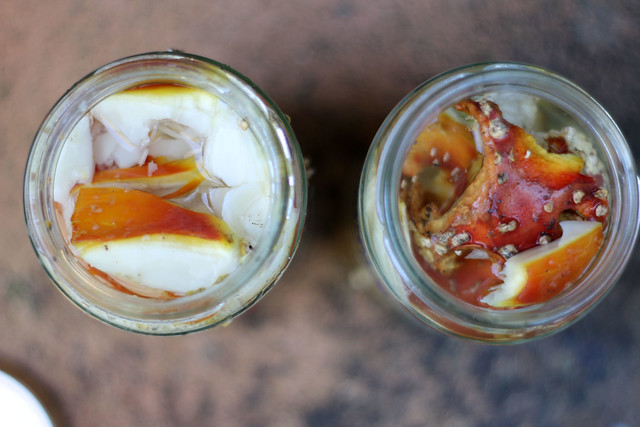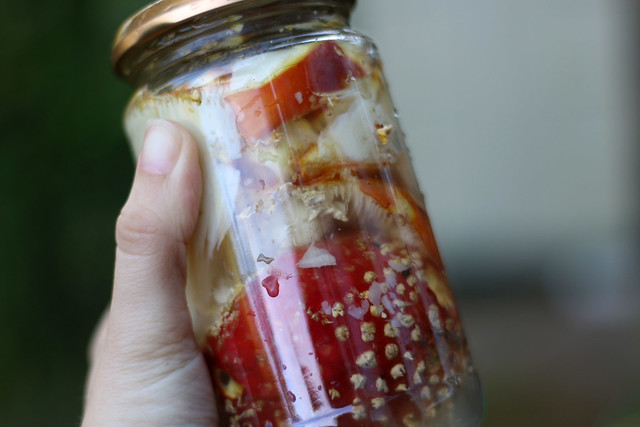When I started experimenting with natural dyeing, I initially assumed that I wouldn’t have much luck in the UK with solar dyeing, particularly in the winter, due to the fact there isn’t all that much sun.
However, I decided to give it a try with some fungi that sprout in our lawn every Autumn. These are fly agaric, a common British/European mushroom, which is mildly toxic and was used in the past for medicinal and religious hallucinogenic purposes. I really like seeing them pop up in our garden as they are so vibrant, but they don’t last for long as slugs love to eat them.
Here’s one that the slugs had already made a good start on!
Due to the toxicity of the fungi I didn’t fancy boiling them for dyeing and releasing any fumes, so attempted solar dyeing. I started the fungi off with some tap water in two jam jars, since these were the only containers I had lying around at home, and I thought if I delayed the slugs would have eaten every last bit. You can see that these jars wouldn’t be any use for dyeing though, since there is no room for any fibre.
I shortly moved the fungi into a large cheap glass jar, purchased from Tiger, and topped it up with additional tap water.
Since I previously harvested my biden plants and completed one batch of biden dyeing, quite a large number of flowers had bloomed. So I decided to pop some Biden flowers in a second jar for solar dyeing.
For the best chance of sunlight, I placed the jars on top of our shed (helpfully there is a small shelf over the door which was perfect). I left them alone for a couple of weeks, by which time both jars had achieved a decent colour.
At this point I added a small section of pre-mordanted yarn (Rowan Big Wool, a 100% merino wool) and pre-mordanted unbleached cotton into each jar. I could have removed the biden flowers at this point (to prevent them getting tangled in the yarn) but didn’t bother. I did remove most of the fungi as it was already starting to look a little moldy.
I read somewhere that a layer of wax on top of the jars can help to avoid mold. I attempted to create this by melting some wax on the surface of each jar. However, I wouldn’t recommend this approach. The liquid was still able to seep through gaps in the wax, and when I came to empty the jars removing the wax was a total pain.
I left the fibre in the jars for another week or two before emptying out the contents. The pictures below show the fibre on immediate removal from the jars, and then hung on the line after a wash.
You can see that I achieved a reasonable pink on the yarn with the fungi, but it had almost no effect on the cotton. The biden, on the other hand, achieved a strong colour on the yarn and cotton. The patchy effect on the cotton is due to how I squashed the fabric into the jar.
I have some natural dyeing planned for today – with some precious British silk – so wish me good results.
P.S. There is a beautiful post on dyeing with mushooms on the Folk Fibres blog.


















